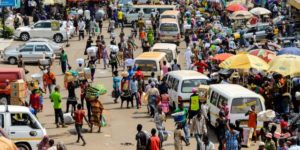- This article considers rising youth unemployment in West Africa and the role of trade and migration in meeting this challenge.
- Lessons and opportunities can be drawn from the implementation of free movement protocols in West Africa, with recommendations on how the rest of Africa can benefit from this experience.
Rising unemployment in West Africa, a growing youth population, and uncertain job prospects due to a lack of good governance and credible government institutions have been listed as contributing to the exodus of citizens from their home nations to other countries within the subregion and outside of the continent. Migratory movements in West Africa are mostly driven by economic reasons, and 84 percent of these movements are destined to another country within the region.
The official youth (aged 15–24 years) unemployment rate in West Africa has hovered between 12–14 percent since 2008. These official rates are however divorced from the reality on the ground. These figures do not include workers employed in the informal sector and the underemployed – both deemed to be vulnerable (precarious) – whose combined rate constitute about 70 percent of the overall workforce. With West Africa’s population expected to double by 2045, what solutions do trade and migration policies hold for the region’s youth?
Citizens of the Economic Community of West African States (ECOWAS) have the right of entry, residence, and establishment within its member states. This is particularly important in a region where economic activities are strongly linked to physical presence. Infrastructure challenges mean that people mostly accompany goods in their movement in the region. Obstacles to the free movement of either persons or goods thus have far-reaching economic effects.
These obstacles to the free movement of people have an effect that is similar to that of non-tariff barriers on the movement of goods. This is especially the case for cross-border (female) traders who mostly trade in agricultural and homemade products, and who cross the border daily in order to sell their goods on either side of the larger border markets.
To address these problems, ECOWAS member states have adopted several policies at the regional level to promote the free movement of goods and persons. Although ECOWAS has gradually implemented free movement protocols in a phased approach since 1979, there are various challenges to the implementation of these policies by national authorities.
Corrupt practices by border officials, for example, prevent smooth border crossings by citizens. There are also irregular fees charged for residence permits as well as other local fees and charges paid at the municipal level. Institutional and policy-related challenges prevail. These range from conflicting national and municipal regulations (e.g. registration of businesses, access to social services, access to credit) to varied interpretations of regional mobility policies by the national authorities.
At the political level, negative perceptions have led to frequent expulsions or threats of expulsions of migrants (and ECOWAS citizens). There are also frequent clashes between the host communities and migrants from other ECOWAS countries due to perceived loss of income or competition for limited job opportunities.
As African countries begin implementing the recent free movement protocol, there are a number of lessons that can be drawn from several decades of implementing the ECOWAS free movement protocols.
Firstly, political will is necessary to support the free movement of persons on the continent. Signing agreements and ratifying them at the national level is usually a signal of high political commitment. However, this political will needs to translate into effective implementation at the level of national agencies such as immigration authorities and border police. This can be done by sensitising these and other relevant agencies to the new policies, and changing standard operating procedures to reflect these new regulations. ECOWAS set up a task force on the free movement of persons and goods in the region to address the political level challenges. This task force carries out missions and reports to the ECOWAS Heads of State and Government on its yearly activities.
Secondly, monitoring the implementation of policies is important. In West Africa, an observatory was established to monitor abnormal practices relating to free movement, which documents irregular practices by national authorities, border agencies, and other stakeholders. The missing link is a mechanism that connects the reports from the observatory to the policymaking process at the national and regional level. To address this gap, the observatory should collaborate with the ECOWAS task force on the free movement of goods and people. The ECOWAS Heads of States and Government has taken the task force reports seriously and implemented their recommendations, especially as they relates to the free movement of goods.
Finally, providing a possibility for policymakers to learn from the best practices that emerge from other states in implementing free movement provisions is beneficial. This peer learning mechanism has proved very successful for ECOWAS.
Labour – a crucial factor of production – is abundant in West Africa and the free movement policies make it highly mobile. However, the unit cost of labour in West Africa is higher than any region with similar per capita income. Theoretically, high labour mobility should promote the emergence in the region of competitive labour-intensive industries such as light manufacturing. However, this is not what we see in practice, mainly due to structural economic and institutional challenges.
A holistic approach towards solving high youth unemployment would involve building credible institutions that promote transparency, implement coherent regulatory frameworks around migration and the free movement of people (labour and talent), promote growth, and contribute to the emergence of a robust private sector.
Regional mobility provisions offer a solution to the challenge of youth unemployment in West Africa by making labour available as a prerequisite for the development of competitive industries.
African governments should take the lead in providing coherent regulatory environments that will ensure the generation of private sector investment. In addition, partnerships between the private sector, the government, and financial institutions are key to boosting economic activities and their potential for employment creation. The end goal is to develop sustainable solutions that will translate into economic growth, a reduction in inequality, and an improvement in the current predicament of youth unemployment.
Clear and transparent implementation of mobility and trade rules and regulations will help create a beneficial framework for productive exchange and growth within the region. Only then can the opportunities for a stronger continent with a promising future for its youth be seized.
–
Amanda Bisong is Policy Officer at the Migration Programme of the European Centre for Development Policy Management (ECDPM), Maastricht.
Credit: www.ictsd.org




